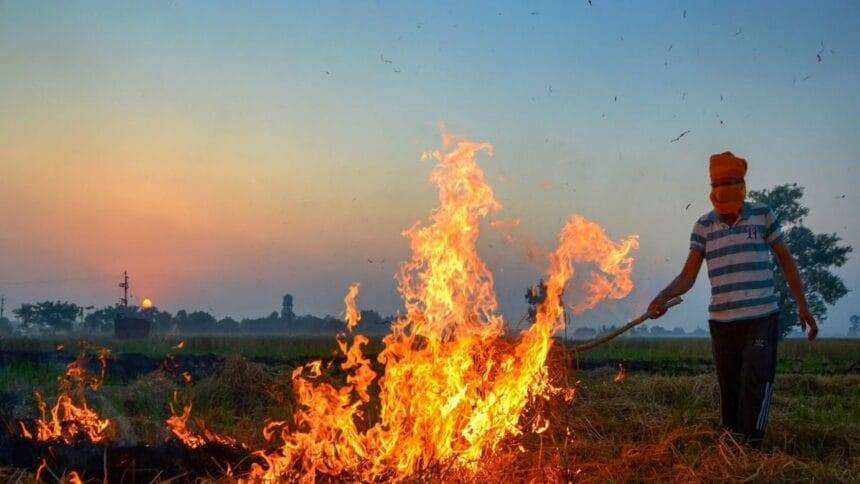Main Points In Hindi (मुख्य बातें – हिंदी में)
-
वायु गुणवत्ता की स्थिति: दिल्ली में वायु गुणवत्ता सूचकांक (AQI) "मध्यम" श्रेणी में 151 दर्ज किया गया है, जो सोमवार को 127 था। यह सूचकांक हवा की गुणवत्ता को दर्शाता है और इसकी रेटिंग स्वास्थ्य पर प्रभाव डाल सकती है।
-
पराली जलाने की घटनाएं: पिछले 15 दिनों में पंजाब में 155, हरियाणा में 84, और उत्तर प्रदेश में 6 पराली जलाने की घटनाएं दर्ज की गई हैं, जिससे प्रदूषण की समस्या बढ़ी है।
-
तापमान में वृद्धि: दिल्ली में मंगलवार को अधिकतम तापमान 35.4 डिग्री सेल्सियस रहा, जो सामान्य से एक डिग्री अधिक है, और न्यूनतम तापमान 26.2 डिग्री सेल्सियस, जो मौसम के औसत से 2.9 डिग्री अधिक है।
-
मौसम पूर्वानुमान: भारत मौसम विज्ञान विभाग ने अगले दिन के लिए साफ आसमान और अधिकतम तथा न्यूनतम तापमान क्रमशः 36 और 26 डिग्री सेल्सियस के रहने की संभावना व्यक्त की है।
- पराली जलाने के प्रभाव: सितंबर से नवंबर के बीच पराली जलाने की घटनाएं सामान्यतः बढ़ जाती हैं, जिससे दिल्ली-एनसीआर के क्षेत्रों में वायु गुणवत्ता में गिरावट आती है, विशेषकर धान की पराली जलाने से उत्पन्न धुएं के कारण।
Main Points In English(मुख्य बातें – अंग्रेज़ी में)
Here are the main points from the article:
-
Air Quality Concerns: There has been a rise in incidents of crop burning in the neighboring states of Delhi, with 155 cases reported in Punjab, 84 in Haryana, and six in Uttar Pradesh over the past 15 days. The Air Quality Index (AQI) in Delhi was recorded in the "moderate" category at 151.
-
Weather Update: The maximum temperature in Delhi reached 35.4 degrees Celsius, which is one degree above normal. The minimum temperature recorded was 26.2 degrees Celsius, exceeding the seasonal average by 2.9 degrees.
-
Forecast: The India Meteorological Department predicts mostly clear skies for the next day, with expected maximum and minimum temperatures around 36 and 26 degrees Celsius, respectively.
-
Impact of Crop Burning: The article highlights that the practice of crop burning, particularly in November, significantly deteriorates air quality in the Delhi-NCR region, primarily due to smoke from the burning of rice straw.
- Current Events: On the same day, there were additional incidents of crop burning reported, including 10 cases in Punjab and one in Haryana.


Complete News In Hindi(पूरी खबर – हिंदी में)
आखरी अपडेट:
दिल्ली में मंगलवार को अधिकतम तापमान 35.4 डिग्री सेल्सियस दर्ज किया गया, जो सामान्य से एक डिग्री अधिक है। (फोटो: पीटीआई फाइल)
हाल के आंकड़ों के मुताबिक, जबकि अधिकांश क्षेत्रों से मानसून वापस चला गया है, पिछले 15 दिनों में पंजाब में पराली जलाने की कुल 155 घटनाएं, हरियाणा में 84 और उत्तर प्रदेश में छह घटनाएं दर्ज की गई हैं।
हाल के दिनों में दिल्ली के पड़ोसी राज्यों में खेतों में आग लगने की घटनाएं बढ़ी हैं, मंगलवार को पंजाब में 26 घटनाएं दर्ज की गईं और राष्ट्रीय राजधानी में वायु गुणवत्ता सूचकांक (एक्यूआई) ‘मध्यम’ श्रेणी में था।
हाल के आंकड़ों के अनुसार, जबकि अधिकांश क्षेत्रों से मानसून वापस चला गया है, पिछले 15 दिनों में पंजाब में पराली जलाने की कुल 155 घटनाएं, हरियाणा में 84 और उत्तर प्रदेश में छह घटनाएं दर्ज की गई हैं।
सोमवार को पंजाब में 10 और हरियाणा में एक घटना सामने आई।
केंद्रीय प्रदूषण नियंत्रण बोर्ड के अनुसार, शहर का 24 घंटे का वायु गुणवत्ता सूचकांक (एक्यूआई) शाम 4 बजे 151 की रीडिंग के साथ “मध्यम” श्रेणी में था, जो सोमवार को 127 था।
इस बीच, भारत मौसम विज्ञान विभाग (आईएमडी) के अनुसार, दिल्ली में मंगलवार को अधिकतम तापमान 35.4 डिग्री सेल्सियस दर्ज किया गया, जो सामान्य से एक डिग्री अधिक है, जबकि न्यूनतम तापमान 26.2 डिग्री सेल्सियस दर्ज किया गया, जो मौसम के औसत से 2.9 डिग्री अधिक है।
मौसम विभाग ने बुधवार को मुख्य रूप से साफ आसमान रहने की भविष्यवाणी की है, अधिकतम और न्यूनतम तापमान क्रमशः 36 और 26 डिग्री सेल्सियस के आसपास रहने की संभावना है।
शून्य और 50 के बीच एक AQI को “अच्छा”, 51 और 100 के बीच “संतोषजनक”, 101 और 200 के बीच “मध्यम”, 201 और 300 के बीच “खराब”, 301 और 400 के बीच “बहुत खराब” और 401 और 500 के बीच “गंभीर” माना जाता है। इस क्षेत्र में पराली जलाने का चरम मौसम नवंबर में होता है और बड़े पैमाने पर धान की पराली जलाने से उत्पन्न होने वाले अत्यधिक धुएं के कारण आमतौर पर दिल्ली-एनसीआर के क्षेत्रों में हवा की गुणवत्ता में भारी गिरावट आती है।
(यह कहानी News18 स्टाफ द्वारा संपादित नहीं की गई है और एक सिंडिकेटेड समाचार एजेंसी फ़ीड से प्रकाशित हुई है – पीटीआई)
Complete News In English(पूरी खबर – अंग्रेज़ी में)
Here’s a simplified version of the content in English:
Latest Update: October 1, 2024, 20:13 IST


In Delhi, the maximum temperature reached 35.4 degrees Celsius on Tuesday, which is one degree above normal. (Photo: PTI file)
Summary: Recent data shows that while the monsoon has retreated from most areas, there have been a total of 155 incidents of stubble burning in Punjab, 84 in Haryana, and six in Uttar Pradesh over the last 15 days.
There has been an increase in agricultural fires in neighboring states of Delhi. On Tuesday, Punjab recorded 26 incidents, causing the air quality index (AQI) in the capital to fall into the "moderate" category.
According to the latest reports, while monsoon conditions have largely disappeared, there were 10 new incidents of stubble burning in Punjab and one in Haryana on Monday.
The Central Pollution Control Board reported that the city’s AQI reading at 4 PM was 151, which falls in the "moderate" category, up from 127 on Monday.
Meanwhile, the India Meteorological Department stated that the maximum temperature in Delhi was 35.4 degrees Celsius on Tuesday, which is one degree above normal, while the minimum was 26.2 degrees Celsius, 2.9 degrees higher than the average.
The weather department has forecasted mostly clear skies for Wednesday, with expected maximum and minimum temperatures around 36 and 26 degrees Celsius, respectively.
The AQI ratings are categorized as follows: 0-50 is "Good," 51-100 is "Satisfactory," 101-200 is "Moderate," 201-300 is "Poor," 301-400 is "Very Poor," and 401-500 is "Severe." The peak period for stubble burning is in November, which typically leads to a major drop in air quality in the Delhi-NCR region due to heavy smoke from burning rice straw.
(This story was not edited by News18 staff and was published from a syndicated news agency feed – PTI)
This summary maintains the key points while using simpler language for better understanding.








